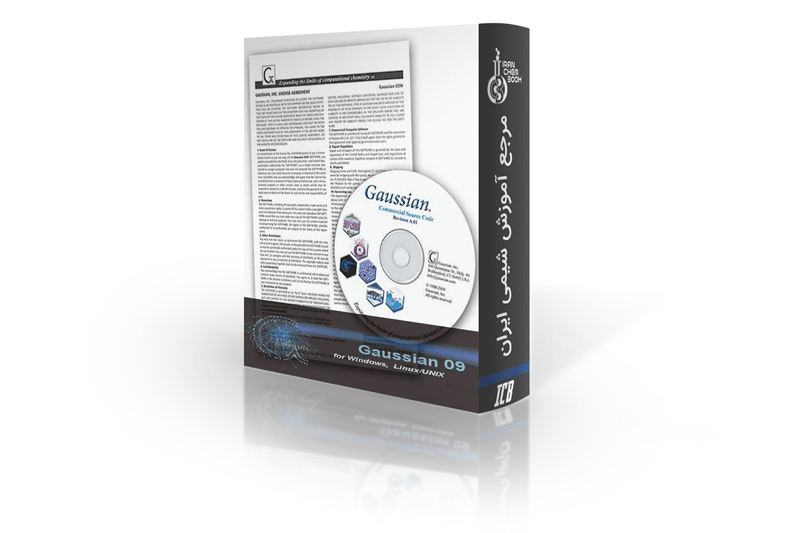نرم افزار گوسین – Gaussian
گوسین از جمله نرم افزارهای شیمی محاسباتی به شمار می رود که قادر به پیشگویی خواص مولکول ها و واکنش های آن ها مانند رسم ساختار بهینه شده مولکول ها، انرژی پیوندی و مکانیسم واکنش ها، انرژی ساختارهای حالت گذار، اوربیتال های مولکولی و بارهای اتمی، الکترونخواهی و پتانسیل یونیزاسیون، طیف های IR و NMR، قابلیت پلاریزاسیون، پتانسیلهای الکتروستاتیک و دانسیته الکترون، فرکانسهای ارتعاشی و خواص ترموشیمیایی میباشد.
این نرم افزار نخستین بار در سال ۱۹۷۰ توسط پروفسور جان پاپل و تیم تحقیقاتی وی در دانشگاه کارنگی ملون با عنوان گوسین ۷۰ منتشر شد.
Gaussian یک نرم افزار شیمی محاسباتی می باشد و شیمیست ها برای محاسبات مولکولی و سنتز مواد آلی و معدنی و همچنین سینتیک از آن استفاده می کنند.
فلسفه تئوری Gaussian بر این پایه استوار است که مدل های تئوری باید برای همه سیستم های مولکولی با هر اندازه و نوعی به طور یکسان قابل اجرا باشند. مدل های شیمیایی در Gaussian از ترکیب روش های تئوری با مجموعه های پایه حاصل شده اند. نرم افزار Gaussian قادر به پیش بینی خواص بسیاری از مولکول ها و واکنش ها می باشد.
محاسبات انجام شده توسط برنامه Gaussian بر روی سیستم ها می تواند مربوط به فاز گازی و یا محلول باشد و همچنین می تواند مربوط به حالت های پایه و برانگیخته باشد. بنابراین Gaussian می تواند به عنوان ابزاری قوی برای بررسی مکانیزم واکنش ها، سطوح انرژی پتانسیل، انرژی های برانگیخته و … به کار رود.
برخی از قابلیت های این نرم افزار
- محاسبه انرژی های مولکولی و ساختار مولکولی
- بهینه سازی هندسه و مدلسازی واکنشهای شیمیایی
- پتانسیل الکترو استاتیک و دانسیته های الکترونی
- تحلیل حالت های برانگیخته مولکول ها
- بهینه سازی خودکار ارتعاشات و یا انرژی های نقطه ای
- اجرای بسیار سریع تر محاسبات فرکانس HF وDFT
- و …

Gaussian 16 is the latest version of the Gaussian series of electronic structure programs, used by chemists, chemical engineers, biochemists, physicists and other scientists worldwide. Gaussian 16 provides a wide-ranging suite of the most advanced modeling capabilities available. You can use it to investigate the real-world chemical problems that interest you, in all of their complexity, even on modest computer hardware.
Fundamental Capabilities
Starting from the fundamental laws of quantum mechanics, Gaussian 16 predicts the energies, molecular structures, vibrational frequencies and molecular properties of compounds and reactions in a wide variety of chemical environments. Gaussian 16’s models can be applied to both stable species and compounds which are difficult or impossible to observe experimentally, whether due to their nature (e.g., toxicity, combustibility, radioactivity) or their inherent fleeting nature (e.g., short-lived intermediates and transition structures).
With Gaussian 16, you can thoroughly investigate the chemical problems that interest you. For example, not only can you minimize molecular structures rapidly and reliably, you can also predict the structures of transition states, and verify that the predicted stationary points are in fact minima or transition structure (as appropriate). You can go on to compute the reaction path by following the intrinsic reaction coordinate (IRC) and determine which reactants and products are connected by a given transition structure. Once you have a complete picture of the potential energy surface, reaction energies and barriers can be accurately predicted. You can also predict a wide variety of chemical properties.
Gaussian 16 offers a wide range of methods for modeling compounds and chemical processes, including:
- Molecular mechanicsEGF: Amber, UFF, Dreiding
- Semi-empirical methodsEGF†: AM1, PM6, PM7, DFTB, among others
- Hartree-FockEGF
- Density functional (DFT) methodsEGF, with support for a plethora of published functionals; long-range and empirical dispersion corrections are available where defined
- Complete active space self-consistent field (CASSCF)EGF, including RAS support and conical intersection optimizations
- Møller-Plesset perturbation theory: MP2EGF, MP3EG, MP4(SDQ)EG, MP4(SDTQ)E, MP5E
- Coupled cluster: CCDEG, CCSDEG, CCSD(T)E
- Brueckner doubles: BDEG, BD(T)E
- Outer Valence Green’s Function (OVGF): ionization potentials and electron affinities
- High accuracy energy models: G1-G4, CBS series and W1 series, all with variants
- Excited state methods: TD-DFTEGF, EOM-CCSDEG and SAC-CIEG
EEnergies; GAnalytic gradients; FAnalytic frequencies; F†Reimplemented with analytic frequencies.
A wide range of Gaussian results can be examined with GaussView’s visualization capabilities:
- Molecule annotations and/or property-specific coloring: e.g., atomic charges, bond orders, NMR chemical shifts
- Plots, including NMR, vibrational and vibronic spectra
- Surfaces or contours: e.g., molecular orbitals, electron density, spin density. Properties such as the electrostatic potential can be visualized as a colorized density surface.
- Animations: e.g., normal modes, IRC paths, geometry optimizations
Explore Exotic Parts of the Periodic Table
Gaussian provides features for modeling heavy elements for which relativistic effects are significant. The Stuttgart-Dresden and Ahlrichs group basis sets+ECPs are built-in, and their treatments of specific elements can be merged with other standard basis sets via very simple input specifications.
www.gaussian.com



سلام. من نیاز به آموزش دارم لطفا راهنمایی فرمایید چطور میتونم آموزش ببینم
با سلام، شما با یک جستجوی ساده در گوگل به راحتی می توانید به منابع آموزشی مرتبط با نرم افزار گوسین دسترسی داشته باشید. ویدئوهای زیادی در یوتیوب و حتی آپارات نیز وجود دارند. موفق باشید
سلام خسته نباشید
بنده در نصب فایل این برنامه به مشکل خوردم و گویی فایل دانلودی خراب است
ممنون میشم اگر کمک کنید
با تشکر
با سلام و احترام، فایل دانلودی بررسی شد و مشکل خاصی وجود ندارد. موفق باشید